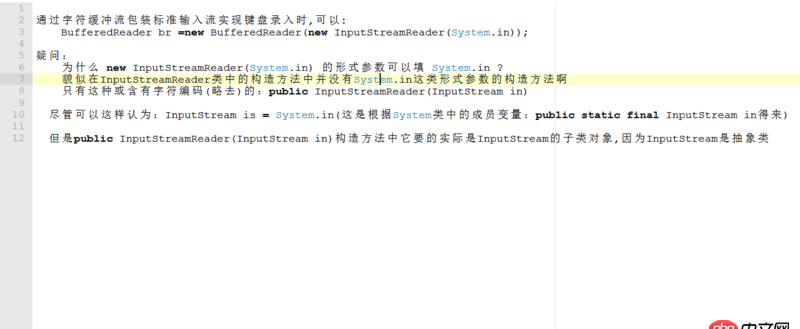通過Java IO流的形式實現鍵盤錄入的疑問
問題描述

問題解答
回答1:因為System.in就是一個靜態的InputStream實例,你可以在java api文檔上看看
回答2:首先,System.in是一個InputStream類型的對象,在源碼里是這樣的:
/** * The 'standard' input stream. This stream is already * open and ready to supply input data. Typically this stream * corresponds to keyboard input or another input source specified by * the host environment or user. */public final static InputStream in = null;
可見System.in屬于標準輸入,可以通過鍵盤或其他方式輸入數據。但在源碼里,該對象并沒有(顯式)初始化的方法,通過閱讀源碼,可發現下面這個方法:
/** * Reassigns the 'standard' input stream. * * <p>First, if there is a security manager, its <code>checkPermission</code> * method is called with a <code>RuntimePermission('setIO')</code> permission * to see if it’s ok to reassign the 'standard' input stream. * <p> * * @param in the new standard input stream. * * @throws SecurityException *if a security manager exists and its *<code>checkPermission</code> method doesn’t allow *reassigning of the standard input stream. * * @see SecurityManager#checkPermission * @see java.lang.RuntimePermission * * @since JDK1.1 */public static void setIn(InputStream in) { checkIO(); setIn0(in);}private static native void setIn0(InputStream in);
閱讀注釋可見該方法用于設定研究setIn0(in),可見該方法是通過調用底層接口來實現in的設定,那么在軟件運行時,是如何初始化的呢?System類中有如下代碼:
/* register the natives via the static initializer. * * VM will invoke the initializeSystemClass method to complete * the initialization for this class separated from clinit. * Note that to use properties set by the VM, see the constraints * described in the initializeSystemClass method. */private static native void registerNatives();static { registerNatives();}/** * Initialize the system class. Called after thread initialization. */private static void initializeSystemClass() {...FileInputStream fdIn = new FileInputStream(FileDescriptor.in);FileOutputStream fdOut = new FileOutputStream(FileDescriptor.out);FileOutputStream fdErr = new FileOutputStream(FileDescriptor.err);setIn0(new BufferedInputStream(fdIn));setOut0(new PrintStream(new BufferedOutputStream(fdOut, 128), true));setErr0(new PrintStream(new BufferedOutputStream(fdErr, 128), true));...}
由此段代碼可知,軟件運行時,先運行靜態代碼塊,調用registerNatives()這個底層方法對System類進行初始化,該方法則是調用initializeSystemClass()方法來初始化System類的,這兩步都是通過VM實現的,然后閱讀initializeSystemClass()這個方法,可見到調用setIn0,setOut0,steErr0三段代碼,分別初始化了標準輸入,標準輸出,標準錯誤三種輸出流,至此System.in、out、err的初始化流程就都弄清楚了。標記為native的方法是JVM調用其他代碼實現的功能,這個和底層有關系,我覺得這個感覺就像是Bootstrap Classloader實際上是C實現,但由JVM調用來加載各個基礎JAR classes相似吧。另外你說InputStream是抽象類(接口),實際上接口類抽象類都可以作為參數,但實現肯定不是他們實現的,他們不能被實現,但可以作為參數,畢竟父類出現的地方子類都可以替代,所以這里不存在問題
相關文章:
1. javascript - webpack1和webpack2有什么區別?2. thinkPHP5中獲取數據庫數據后默認選中下拉框的值,傳遞到后臺消失不見。有圖有代碼,希望有人幫忙3. django - Python error: [Errno 99] Cannot assign requested address4. 求救一下,用新版的phpstudy,數據庫過段時間會消失是什么情況?5. python小白,關于函數問題6. javascript - vscode alt+shift+f 格式化js代碼,通不過eslint的代碼風格檢查怎么辦。。。7. python小白 關于類里面的方法獲取變量失敗的問題8. Python2中code.co_kwonlyargcount的等效寫法9. [python2]local variable referenced before assignment問題10. python - vscode 如何在控制臺輸入

 網公網安備
網公網安備